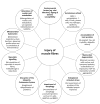Sporadic inclusion body myositis: new insights and potential therapy
- PMID: 25159931
- PMCID: PMC4248565
- DOI: 10.1097/WCO.0000000000000129
Sporadic inclusion body myositis: new insights and potential therapy
Abstract
Purpose of the review: To describe new insights and developments in the pathogenesis, diagnosis and treatment of sporadic inclusion body myositis (IBM).
Recent findings: Various hypothesis about the pathogenesis of IBM continue to be investigated, including autoimmune factors, mitochondrial dysfunction, protein dyshomeostasis, altered nucleic acid metabolism, myonuclear degeneration and the role of the myostatin pathway. Serum autoantibodies against cytosolic 5'-nucleotidase 1A have been identified in IBM showing moderate diagnostic performance. The differential diagnostic value of histopathological features, including different protein aggregates, continues to be evaluated. MRI may also be of monitoring value in IBM. New therapeutic strategies are being tested in IBM patients, namely the upregulation of the heat shock response and the antagonism of myostatin.
Summary: Recent important advances have occurred in IBM. These advances, including recent and ongoing clinical trials, may lead to earlier diagnosis and improved understanding and treatment of the disease. Despite improved knowledge, IBM continues to be a puzzling disease and the pathogenesis remains to be clarified. An interdisciplinary, bench to bedside translational research approach is crucial for the successful identification of novel treatments for this debilitating, currently untreatable disorder.
Conflict of interest statement
Figures



References
-
- Needham M, James I, Corbett A, Day T, Christiansen F, Phillips B, et al. Sporadic inclusion body myositis: phenotypic variability and influence of HLA-DR3 in a cohort of 57 Australian cases. Journal of neurology, neurosurgery, and psychiatry. 2008 Sep;79(9):1056–1060. - PubMed
-
- Benveniste O, Guiguet M, Freebody J, Dubourg O, Squier W, Maisonobe T, et al. Long-term observational study of sporadic inclusion body myositis. Brain. 2011 Nov;134(Pt 11):3176–3184. - PubMed
-
- Dimachkie MM, Barohn RJ. Inclusion body myositis. Current neurology and neuroscience reports. 2013 Jan;13(1):321. - PubMed
Publication types
MeSH terms
Substances
Grants and funding
LinkOut - more resources
Full Text Sources
Other Literature Sources
Molecular Biology Databases
Research Materials

